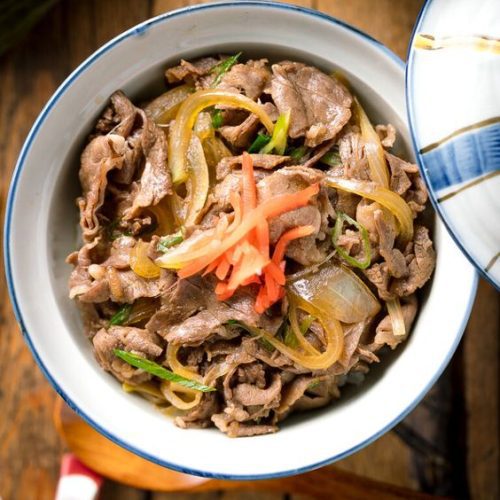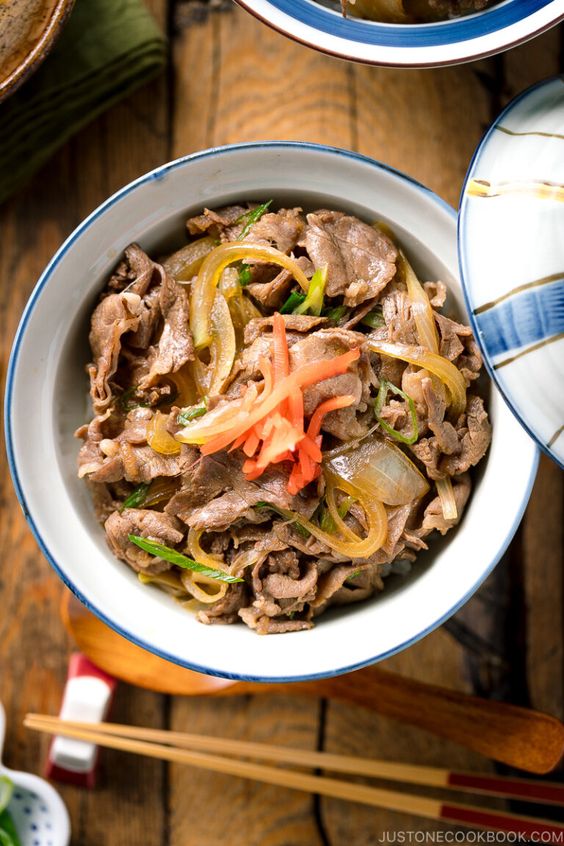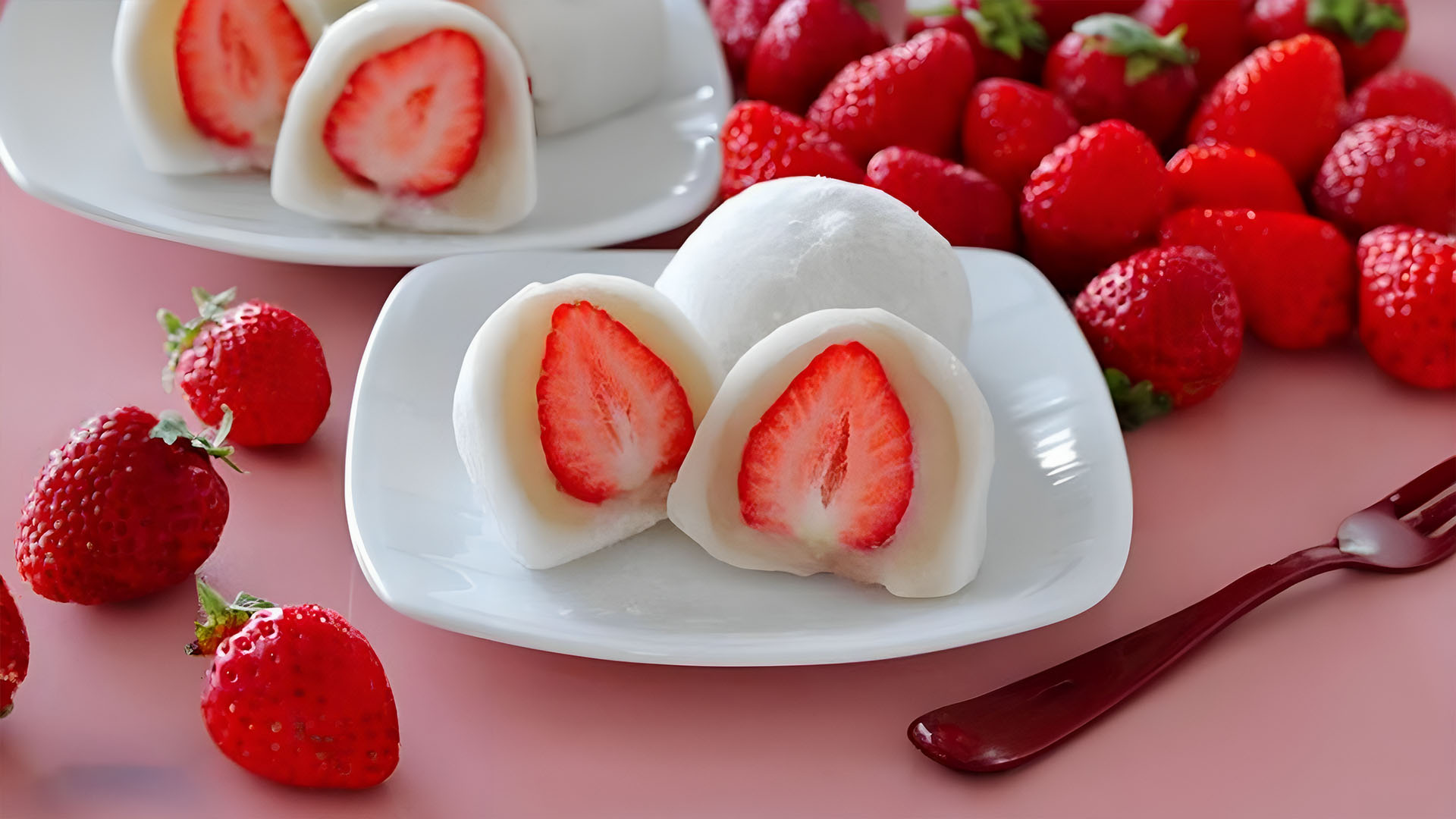Gyudon Recipe – Few foods in the realm of Japanese cuisine can compare to the cozy and alluring appeal of Gyudon. This mouthwatering composition of thinly sliced beef, tenderly cooked in a sweet soy sauce, and artfully arranged atop steamed rice captures the absolute best of culinary pleasure. Join us as we go out on a culinary trip to discover how to make the ideal Gyudon in the convenience of your own home. Get ready to be mesmerized by the flavors and traditions of Gyudon by learning the history of this Japanese gem and mastering the technique of its preparation. Greetings and welcome to a culinary journey through the art and tradition of Japanese comfort cuisine.
Gyudon Recipe
The History of Gyudon
The well-known Japanese beef bowl known as gyudon has a long history that represents the development of Japanese cuisine and the nation’s adaptation to modernity. When we investigate the history of this well-known dish, we learn a tale that combines custom, practicality, and the enduring allure of simplicity.
- Early Influences: The origins of Gyudon can be found in the late 19th century, when Japan was experiencing an upsurge in Western influence. Due to the removal of the meat consumption limitations during this time, beef dishes became increasingly common in Japanese cuisine.
- Western-Style Beef Stews: When Gyudon first appeared, it was modeled after Western-style beef stews that had been imported by foreigners to Japan. Typically, the meat in these stews was thinly sliced and cooked in a delicious broth.
- Transition to Modern Gyudon: Gyudon underwent a number of notable changes over time. One significant modification was the addition of a sweet soy-based sauce, which gave the food a distinctively Japanese flavor profile. The addition of caramelized onions also become a trademark of contemporary Gyudon.
- Gyudon’s post-World War II popularity grew dramatically as a result of its reasonable price, easy accessibility, and comforting flavors. At this time, as Japan was rebuilding from the destruction of war, gyudon became a popular and affordable meal choice.
- The Gyudon Bowl Revolution: The idea of the Gyudon bowl, in which the meal is served over a bowl of steamed rice, became a crucial component of its character. It provided a practical and satisfying way to indulge in Gyudon’s flavors.
- Chain Restaurants & Fast Food: Chain eateries that focus on quick-service meals are what helped Gyudon gain popularity. Gyudon became widely accessible thanks to chains like Yoshinoya and Sukiya, further solidifying its reputation as a beloved fast food.
Gyudon is now more than just a food item; it is a representation of Japanese cuisine’s versatility and inventiveness. Japan’s ability to adapt foreign culinary influences to make them uniquely Japanese is demonstrated by its history. Gyudon continues to entice taste buds and warm hearts, having evolved from its humble beginnings as a comfort food staple inspired by Western stews.
You are not just enjoying a meal when you relish the flavors of gyudon; you are also getting a sense of Japanese culinary history and the persistent allure of a dish that has weathered the test of time. Gyudon serves as a reminder that sometimes the most unique flavors may be created using the most basic materials and endearing customs.
The difference between Gyudon and Donburi
Gyudon is a kind of donburi, although there are differences between the two as well:
- Gyudon (Beef Bowl): Gyudon is a dish made of steamed rice and thinly sliced beef that has been cooked in a sweet soy sauce. Caramelized onions are frequently added as a garnish. The beef’s savory-sweet flavor is highlighted.
- Donburi (Rice Bowl): Donburi is a general term for a group of Japanese foods that are served with a bowl of rice and a variety of toppings. Just one kind of donburi is gyudon. Katsudon (breaded pork cutlet), Oyakodon (chicken and egg), and Unadon (grilled eel) are some of the other well-known donburi meals.
Gyudon is essentially a sort of Donburi that only has beef, whereas Donburi includes a wide variety of toppings and flavors, making it a flexible category of Japanese cuisine.
Is Gyudon a fast food?
In Japan, gyudon is frequently connected to fast food. This is why:
- Gyudon is renowned for its quick preparation, for one. It’s a go-to choice for people who are busy and want a quick but tasty lunch.
- Gyudon is reasonably priced, making it available to a wide spectrum of people. In fast food chains, the prices are frequently reasonable.
- Chain Restaurants: Gyudon is frequently found at chains that adhere to the fast-food paradigm by providing quick service and uniform menus, such as Yoshinoya and Sukiya.
It’s important to remember that not every gyudon is regarded as fast food. Gyudon is a premium dish that is produced with premium ingredients and painstaking attention to detail and is offered in some posh restaurants and specialty stores.
The Flavor of Gyudon
Gyudon’s attraction is due to the tastes that make up its tasteful fusion:
- Beef: The tender beef is thinly sliced and cooked in a sweet soy sauce for a flavor that is at once cozy and decadent.
- Onions: To balance the rich aromas of the beef, caramelized onions give a slight sweetness and a tinge of umami.
- Rice: The steamed rice acts as the dish’s base, soaking up the flavorful sauce and offering a plain background that lets the beef and onions take center stage.
- Condiments: You can alter the flavor profile to your preference by adding extras such pickled ginger, red pickled beni shoga, or shichimi togarashi (a seven-spice blend).
- Texture: Another factor contributing to the attractiveness of gyudon is the contrast in textures between the soft onions, tender beef, and fluffy rice in each bite.
Easy Gyudon Recipe / How to Make Gyudon :
Now, let’s explore how to prepare Gyudon in your own kitchen. Here’s a step-by-step recipe:

Gyudon Recipe
Equipment
- Large Pan
- Sharp knife
- Plates or Bowls
Ingredients
- 300 g thinly sliced beef (sirloin or ribeye)
- 2 large onions, thinly sliced
- 2 cup dashi stock (or substitute with beef or vegetable broth)
- 3 tbsp soy sauce
- 3 tbsp mirin (sweet rice wine)
- 2 tbsp sugar
- 1 tbsp sake (Japanese rice wine)
- 2 cups cooked Japanese short-grain rice
- Pickled ginger, for garnish (optional)
- Shichimi togarashi (seven-spice blend), for garnish (optional)
- Sliced green onions, for garnish (optional)
Instructions
Get the ingredients ready:
- Thinly slice the beef.
- Slice the onions very thinly.
- Dashi stock, soy sauce, mirin, sugar, and sake should all be combined in a small bowl.
Cook the Onions:
- With a little oil, heat a big pan.
- The onions should be sautéed until soft and browned.
Add the Beef:
- Add the sliced beef and sauté until it changes color.
Add the Sauce Mixture:
- Pour into the pan the concoction of dashi stock, soy sauce, mirin, sugar, and sake.
- Bring the mixture to a boil, then lower the heat and simmer it for however long it takes for the beef to become soft and the sauce to be absorbed.
Serving:
- Bowls of cooked Japanese short grain rice should be topped with gyudon.
- If desired, garnish with shichimi togarashi (seven spice combination), pickled ginger, or thinly sliced green onions.
Conclusion: Enjoying Gyudon’s Savory Simplicity.
In the world of comfort food from Japan, Gyudon is a symbol of the enchantment that may be created from simplicity. This well-known meal, which is made of thinly sliced beef cooked in a sweet soy sauce and served over a bed of steaming rice, captures the comforting spirit of Japanese food. We are reminded of a few important lessons as we bring our culinary adventure to an end by making gyudon.
- Harmony in Simplicity: Gyudon shows us that sometimes the most basic ingredients produce the most exquisite flavors. A harmonic dish that pleases the palate is produced when tender beef, caramelized onions, and a delicious sauce are combined and served over a bed of rice.
- Gyudon is a gem in and of itself, but its adaptability also allows for customization. Gyudon can be customized to your liking, whether you decide to add pickled ginger as a garnish, a dash of shichimi togarashi for heat, or a layer of sliced green onions.
- Fast Food or Home Comfort: Gyudon’s popularity as both a beloved home-cooked dish and a popular fast-food dish in Japan speaks to its versatility in a variety of culinary contexts. Gyudon continues to be a representation of ease and fulfillment, whether it is eaten at a busy restaurant or tenderly prepared in your own.
So, when you indulge in each bite of Gyudon, keep in mind that you are also engaging in a long-standing culinary tradition. Gyudon encourages us to savor the depth of flavor, the elegance of simplicity, and the enduring allure of Japanese comfort food. Gyudon delivers a sense of Japan’s heart and soul in every flavorful bite, whether it’s a quick midweek meal or a leisurely weekend indulgence.











Leave a Reply